

 The South African
The South African
by W Bergh, W Smith, W Botha, and M Laing
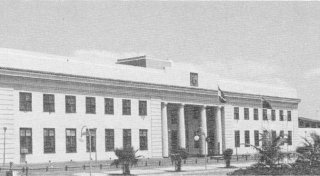
1 The White House; the headquarters building of Natal Command, built in 1937. This is a familiar landmark to the thousands of surfers and holidaymakers who swim at Battery Beach (so named because a battery of heavy guns stood there for many years).
JLB, as Dr Smith was known, was a lecturer in organic chemistry at the university but was also an acknowledged expert on the fishes of the Southern African seas. Unfortunately, he was on holiday at Knysna at the time, over 500 km away, and the letter only reached him on 3 January 1939, eleven days later! There followed a frantic series of letters and telegrams between Knysna and East London,(2) but it was only on 16 February 1939, after being delayed by rain and impassable muddy roads, that JLB finally arrived at the East London Museum to look at the specimen. On seeing it he said, 'that first sight hit me like a white-hot blast and made me feel shaky and queer, my body tingled. I stood as if stricken to stone'.(3) He had identified the first living coelacanth ever known to mankind. Alive! A fish that was supposed to have become extinct 200 million years ago. Fate had tapped him on the shoulder and smiled.
Then began J L B Smith's pursuit phase. For fourteen years he systematically searched the coastline of South and East Africa for further specimens. Finding a second live coelacanth became an obsession. In 1948 he had printed and distributed hundreds of leaflets in Portuguese, English and French, which offered a reward of £100 for a live coelacanth.4 (At that time £100 was an enormous sum, equivalent to a year's salary for most people in Africa!)
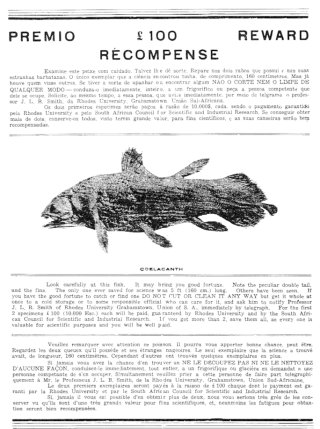
2 The leaflet in three languages offering a £100 reward for a living coelacanth, which finally led Captain Hunt to the specimen that spent the night of 29 December1952 at Natal Command.
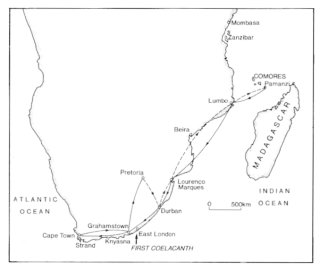
3 The flight route of Dakota 6832(KOD): 28 December - 31 December 1952; Swartkops - Durban - LM - Lumbo - Pamanzi - Lumbo - LM - Durban - Grahamstown - Ysterplaat - Grahamstown - Swartkops.
The real problem was how to get to Dzaoudzi in the Comores Islands, collect the fish and bring it home. JLB began telephoning every person who might help him, from the President of the CSIR to Cabinet Ministers whom he had met as a result of his scientific work. However, it seemed hopeless, as it was Christmas and everyone seemed to be on holiday. Finally, in desperation, he appealed directly to the Prime Minister, Dr D F Malan. (This was made possible through Dr Vernon Shearer, a dentist by profession, and Member of Parliament for Durban. He considered the situation to be so important for science to warrant disturbing the Prime Minister who was on his Christmas vacation!) Then at 23:00 on the night of 26 December the phone rang for JLB; it was the Prime Minister calling. He had decided to help. Next morning early, on 27 December, Dr Malan instructed the Chief of the Defence Force, Lt Gen C L de Wet du Toit, DSO and bar, to make available an aircraft to fly Professor Smith to the Comores to collect the coelacanth.(7) This was truly a decision of remarkable vision!
JLB had to explain in detail* the situation to Brigadier S A Melville, OBE, Acting Chief of Air Staff and Officer Commanding 1 Group South African Air Force (Defence Headquarters, Pretoria). Within the day he communicated to Brigadier H Daniel, Officer Commanding Natal Command, that a Douglas C47 Dakota would be flying down from Swartkops Air Force Base to take JLB to the Comores to collect the coelacanth.(8) At 05:00 on Sunday 28 December 1952, SAAF Dakota No 6832(KOD) and its six-man crew landed at Stamford Hill Aerodrome behind Natal Command. The great adventure had begun.
[Footnote
* The bill for the calls on Dr George Campbell's phone on 27 December was £31 - an enormous sum. This
gives an idea of how complex the negotiations were between JLB, the Prime Minister, and Brigadier Melville.]
By 07:00 they were off, flying north via Lourenço Marques. JLB wanted to make coffee by boiling some water on his portable Primus stove, and was somewhat distressed when Lt D Ralston informed him that this was not allowed because of the danger of fire. At 15:30 they landed at the village of Lumbo in Northern Mozambique where they spent the night.9 At 04:30 on 29 December, they took off on the final leg to that special island called Pamanzi where Captain Hunt waited with the coelacanth in the harbour of Dzaoudzi.
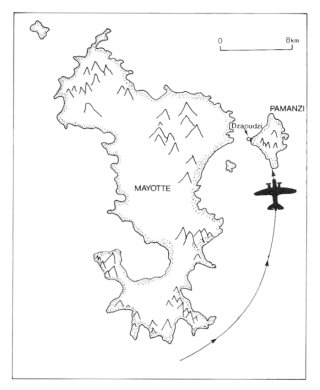
4 Map of the islands of Mayotte and Pamanzi showing the Dakota's route in to the landing strip. Dzaoudzi lies on the coast facing Mayotte.
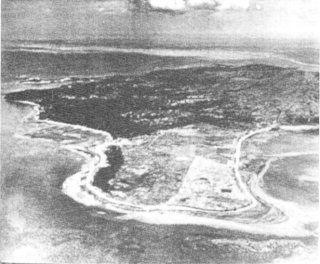
5 An aerial view of Pamanzi showing the landing strip - the roughly cleared area in the foreground.
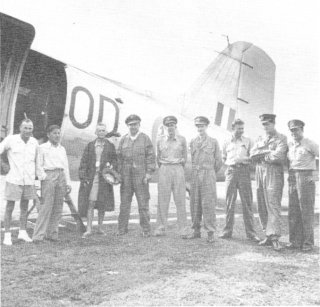
6 This is a unique photograph: the only one ever known to have been taken of a SAAF Dakota on the airstrip at Pamanzi. The aircrew are obviously in their uniforms; J L B is in his shorts, shoes with no socks, and pith helmet; Captain Hunt is next to him. Note how JLB is also wearing a raincoat and the water spots on Hunts trousers from the brief rain squall.
JLB and the aircrew then joined the Governor in his Residence for a quick celebration, with toasts of wine and vintage brandy and a glorious chocolate cake.(12) The aircrew would have liked to stay on to enjoy the palmed-lined beaches and indulge in a little fishing and sailing on Hunt's schooner, but JLB was adamant: they had to leave. So the coelacanth in its box (complete with smell) was loaded onto the Dakota, and the group flew back to Durban. It was 10:00; they had been on the ground at Pamanzi barely three hours, yet it had seemed like an age. The flight back was eventless, with brief stops at Lumbo and Lourenco Marques. By then the members of the crew were very tired, and while they were in the air, JLB asked them to record their thoughts when they were first informed about the flight. Here are three records:(13)
Cmdt J P D Blaauw (pilot): 'It must be a pretty important fish if the Prime Minister is prepared to give an aircraft and a crew to some hare-brained scientist to fetch it.'
Capt P Letley (co-pilot): 'The orderly officer told me we were going to fetch a fish (dead). My reply cannot be written down.'
Lt W J Bergh (navigator): 'I was all set to go on a special visit to my girlfriend for the weekend. I had to cancel all arrangements by phone so I didn't like the idea very much.'
Despite this, when JLB had wept at seeing the coelacanth, the six crew men could sense the historic significance of the occasion and wept with him in sympathy and relief. They had become a team.
After a gruelling trip of eleven hours, Dakota 6832 (KOD) landed at Stamford Hill Aerodrome and taxied up to the apron; aircraft, crew and coelacanth were back safely. What a day it had been, starting at 04:30 at Lumbo, then 07:00 at Dzaoudzi to collect the coelacanth (and enjoy the chocolate cake!), and finally home at 21:00! The fuselage door was opened, and Professor J L B Smith stepped out into a blast of flash bulbs and news reporters. The SABC broadcast a live radio interview.(14) JLB and his fish were world news!
JLB was assigned sleeping quarters in the Headquarters Building of Natal Command for the night. The coelacanth was to have been placed in a nearby bungalow under special guard, but this did not satisfy JLB. He insisted that his coelacanth remain with him; and so it was brought up to HQ and he and his smelly treasure in its coffin-like box spent a secure night in Room 47 of the White House at Natal Command under the watchful eye of those Zulu guards that had been specially detailed for the occasion.
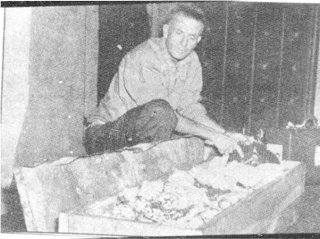
7 Professor J L B Smith with his coelacanth on the steps of White House. Note the studded mahogany panelled door in the background; it is still there. This photograph was taken at about 23:00 on 29 December 1952, just before Malania was carried up to the bedroom where J L B spent the night with it beside him.
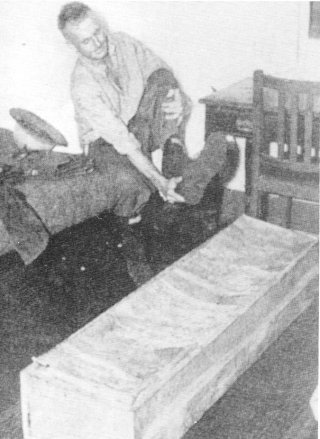
8 JLB taking off his boots in his bedroom, No 47 on the first floor; with his coelacanth at his feet. It is now about 2:00 on 30 December and he is still besieged by reporters.
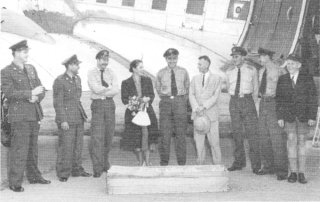
9 The Dakota, its crew, Professor and Mrs Smith and William on the airfield
at Grahamstown, just before take off to fly to Ysterplaat, to show the
coelacanth to Dr D F Malan, the Prime Minister From left to right are:
Lt W J Bergh (navigator), Cpl F Brink, Cpl J W J van Niekerk, Mrs
Margaret Smith, Commandant J P D Blaauw (pilot), Professor J L B
Smith, Capt P Letley (co-pilot), Lt D M Ralston (navigator), William Smith.
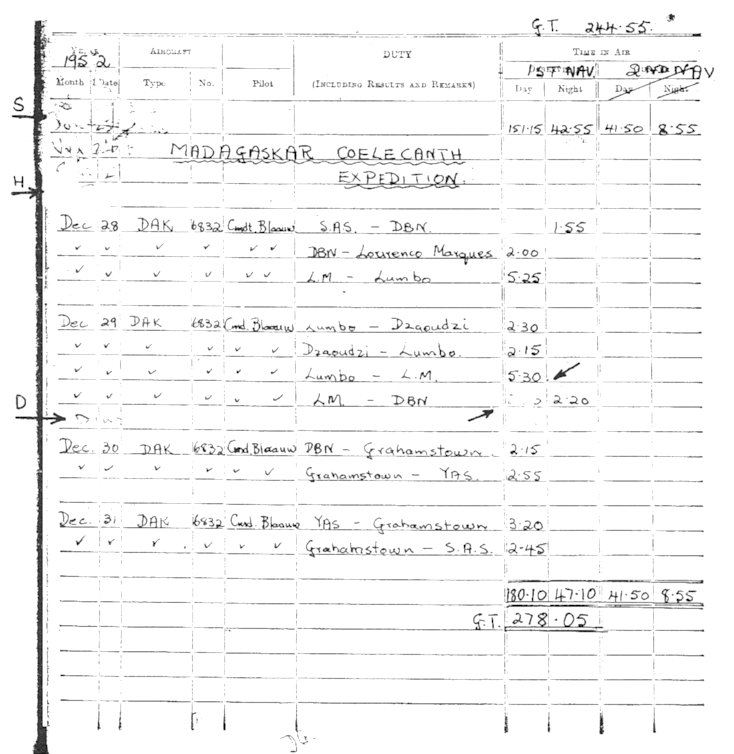
10 The page from Lt Berghs Log Book, (DD 461 A), dated 28 December to 31 December 1952. In simple numbers are recorded the hours and minutes spent in the air for each leg of the flight. Note how the whole amazing adventure is reduced here to only dry numbers. But look carefully at the line 'Dec-29-DAK-LM-DBN' and the smudge to the left of 2:20 (marked with arrows). Lt Bergh was so tired at this stage that he recorded the 2:20 time for the night flight from LM to Durban in the wrong column. He erased the number; thus causing the smudge, and then correctly listed it under Night.
Dr Malan looked into the box containing the corpse of a large, somewhat battered fish smelling of formalin and ten days of decomposition, and then made the classic remark:(15) 'My, it is ugly. Do you mean to say that we once looked like that, and it's named after me?'
The Smiths and the coelacanth then returned to Ysterplaat to collect William who had been left behind to watch the SAAF jets: 'Quite spectacular, fantastic; I had never seen a jet fighter flying before. They were far more exciting than an old fish.'
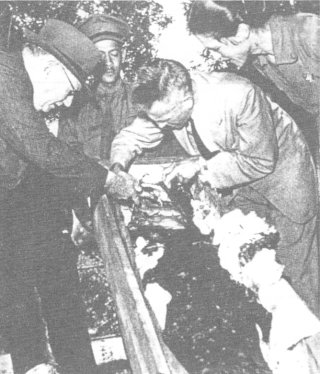
11 Dr D F Malan examines the coelacanth in the garden of his home at the Strand, 30 December 1952.
It was 31 December, the last day of 1952, when Dakota 6832 took off from Grahamstown to fly back to the relative peace, quiet and sanity of Swartkops Air Force Base. The crew was exhausted, but they were spurred on by the great prize: the acclaimed SAAF New Year's Eve Ball! That night, the six of them really celebrated, tired but triumphant. It was all over and Dakota 6832(KOD) had had a moment with destiny.
What has befallen old 6832 over the past forty years? Gone to the scrap heap many years ago, like the Sunderlands and so many other important parts of our history? No! Dakota 6832 is still going strong, sturdily doing its maritime work as part of 35 Squadron at Ysterplaat (where it brought Malania after its first experience of long-range maritime flying so long ago).
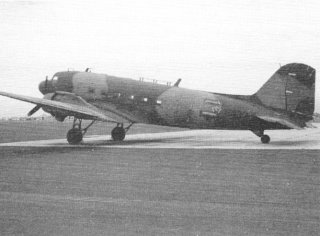
12 SAAF Dakota 6832(KOD), still very much operational at Ysterplaat in 1991 at a young age of 50 years, just waiting to take off and go!
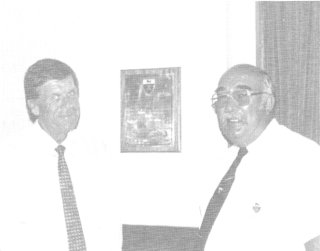
13 Brigadier J H Pretorius, Officer Commanding Natal Command (right) and Mr William Smith, son of JLB and Margaret Smith, (left) at the unveiling of the memorial plaque in the Headquarters Building, on 29 December 1991.
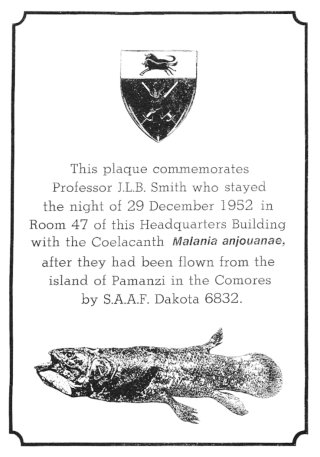
14 Detail of the memorial plaque on the wall of the White House, Natal Command, Durban.
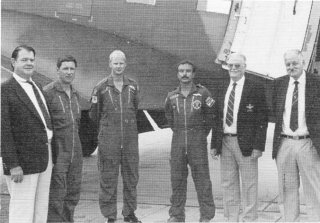
15 Genls Willem Bergh (left) and Duncan Ralston (right). SAAF (retd) and Gen Retzold, in front of Dakota 6832, on 29 December, 1991.
Dr Malan responded to JLB's plea for help because he knew of JLB's eminence as an ichthyologist. In fact, Dr Malans had a copy of JLB's book, Sea Fishes of Southern Africa, with him in his home at the Strand for holiday reading, and he had been looking at it when JLB made his telephone call for help.
References
References labelled (a) are to the book Old Fourlegs by Professor J L B
Smith, published 1956, Longmans, Green, London; those labelled (b)
are to Old Man Coelacanth by Mrs Shirley Bell published in 1969,
Voortrekker Pers, Johannesburg.
William Smith is the son of J L B and Margaret Smith. He obtained a BSc degree in 1959 from Rhodes University and a MSc degree in organic chemistry from the University uf Natal, Pietermaritzburg. He is director of Star Schools and runs the well-known Argus and Daily News Winter Schools for high school pupils; and is now pioneering educational programmes on South African television.
Willem Botha is a staff officer with the rank of commandant at Natal Command, and has served in the SADF since 1960, first in the Citizen Force and since 1979 in the Permanent Force.
Michael Laing is Professor of Inorganic Chemistry at the University of Natal in Durban.
(Someone's comment about the authors was: 'Chemists are notorious for never doing chemistry. JLB collected fish; the next one joined the Air Force; another one is into TV; and the last one is writing stories about fish in aeroplanes! What a bunch!')
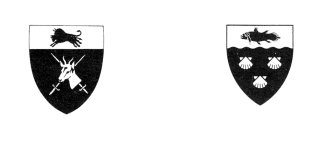
Return to Journal Index OR Society's Home page
South African Military History Society / scribe@samilitaryhistory.org